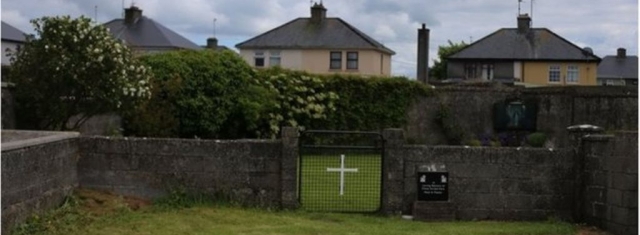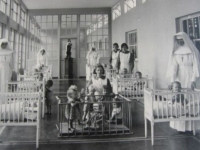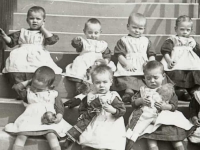News
Bon Secours Mother and Baby Home Mass Grave
Excavation Could Begin This Year

Bon Secours Memorial Site (Source: BBC.com)
USPA NEWS -
The remains of children buried in a mass unmarked grave in Tuam, County Galway, Ireland, that were found March 3rd, 2017, could be exhumed later this year.
Between 1925 and 1961, a Roman Catholic order of nuns called the Bon Secours Sisters operated the Bon Secours Mother and Baby Home, an institution where unmarried pregnant women gave birth in Tuam, Ireland. Pregnant women who delivered their infants at the Home were required to work at the Home for no less than one year without pay. The Irish government and the Catholic Church endorsed the Mother and Baby Home as a means to limit the number of children born out of wedlock by discouraging women from getting pregnant before marriage. During the Home’s thirty-six years of operation, the nuns reported that almost 800 children died in their care. In 2015, researchers discovered and exhumed a tomb of 796 infant and child skeletons in a septic tank underneath where the Home once stood. The acceptance and use of Mother and Baby Homes revealed the way Ireland treated pregnant women in the twentieth century.
The Bon Secours Sisters were a congregation of Roman Catholic nuns who officially assembled in Paris, France, in 1824. A majority of the Sisters were trained nurses or midwives. The term, bon secours, translated from French, means good will. The Bon Secours Sisters’ original motto was good will to all, and they sought to provide efficient nursing care to the less fortunate, particularly those of low socioeconomic status. In the mid-1800s, the Bon Secours Sisters established convents outside of France in the United Kingdom and the United States. In the United States, the Sisters traveled to Maryland, beginning a convent which, in 1919, became the Bon Secours Hospital. As of 2018, that hospital still operates in Baltimore, Maryland. In 1925, the Bon Secours Sisters opened the Bon Secours Mother and Baby Home in Tuam, Ireland.
Institutions for unwed pregnant women and their infants, such as the Bon Secours Mother and Baby Home, were prevalent across Ireland during the late nineteenth century and into the twentieth century. According to researcher Catherine Corless, there was a significant stigma in Ireland against unmarried mothers. Many citizens of Ireland practiced Catholicism, a religion that required women to marry before becoming pregnant. Irish citizens considered infants born out of wedlock illegitimate or bastard children. In addition, the government of Ireland passed an 1841 law called the Offenses Against the Person Act, which made abortion under any circumstance illegal in Ireland. The law ordered that women who received abortions be imprisoned for the rest of their lives. Therefore, women who became pregnant outside of marriage had few options.
Many infants died due to unsafe and unsanitary living conditions at the Mother and Baby Home. Some researchers argue that due to the cramped living conditions and the country’s lack of assistance to help contain diseases, there was an increased risk of children spreading communicable diseases, such as tuberculosis, influenza, and measles. The nuns registered the infants’ and children’s deaths with the Tuam City Council death register, providing the deceased’s name, age, and cause of death. Some reports found that over 800 infants aged from birth to three years of age died within the Mother and Baby Home’s thirty-six-year existence. For example, Ireland’s infant mortality rate in 1969 was between 20 and 30 infant deaths per one thousand live births. In 1925, the year the Home opened, seven children died from communicable diseases such as whooping cough or measles. Twenty-four children died in 1932. Thirty-two children died in 1933. While the diseases that killed the infants and children in the Home varied, many of the children also died due to severe malnourishment. After forty children had died in the home in 1940, Ireland’s government sent out an inspector to examine the living c
In 2017, the further discovery of an underground structure divided into 20 chambers, contains significant quantities of human remains. The discovery confirms decades of suspicions that the vast majority of children who died at the home were interred on the site in unmarked graves, a common practice at such Catholic-run facilities amid high child mortality rates in early 20th-century Ireland.
The remains of the children buried in the unmarked grave, could be exhumed later this year under newly -published legislation. If passed, the bill will allow remains to be exhumed and, where possible, identified and returned to relatives. The draft legislation sets out the rules on how and when the state should intervene to exhume human remains in cases, like Tuam, where inappropriate burials have taken place.
Thank you for reading my article. These are merely my thoughts and insights based on the facts. I use only verified sources. No fake news here. You can follow me on Instagram at @wendywesthoven or on Twitter at @wendy_westhoven.
Wendy writes for the United States Press Agency and is a former columnist with the Fulton County Expositor, Wauseon, Ohio.
Sources:
BBC News. (2022, February 22). Tuam babies: Excavation at mass grave could begin this year. Retrieved from https://www.bbc.com/news/world-europe-60464447.
Darby, A. (2019, June 7). Bon Secours Mother and Baby Home (1925–1961). Retrieved from https://embryo.asu.edu/pages/bon-secours-mother-and-baby-home-1925-1961.
The Guardian. (2017, March 3). Mass grave of babies and children found at Tuam care home in Ireland. Retrieved from https://www.theguardian.com/world/2017/mar/03/mass-grave-of-babies-and-children-found-at-tuam-orphanage-in-ireland.
Wendy writes for the United States Press Agency and is a former columnist with the Fulton County Expositor, Wauseon, Ohio.
Sources:
BBC News. (2022, February 22). Tuam babies: Excavation at mass grave could begin this year. Retrieved from https://www.bbc.com/news/world-europe-60464447.
Darby, A. (2019, June 7). Bon Secours Mother and Baby Home (1925–1961). Retrieved from https://embryo.asu.edu/pages/bon-secours-mother-and-baby-home-1925-1961.
The Guardian. (2017, March 3). Mass grave of babies and children found at Tuam care home in Ireland. Retrieved from https://www.theguardian.com/world/2017/mar/03/mass-grave-of-babies-and-children-found-at-tuam-orphanage-in-ireland.
more information: https://www.westhoven.uspa24.com/
Liability for this article lies with the author, who also holds the copyright. Editorial content from USPA may be quoted on other websites as long as the quote comprises no more than 5% of the entire text, is marked as such and the source is named (via hyperlink).







